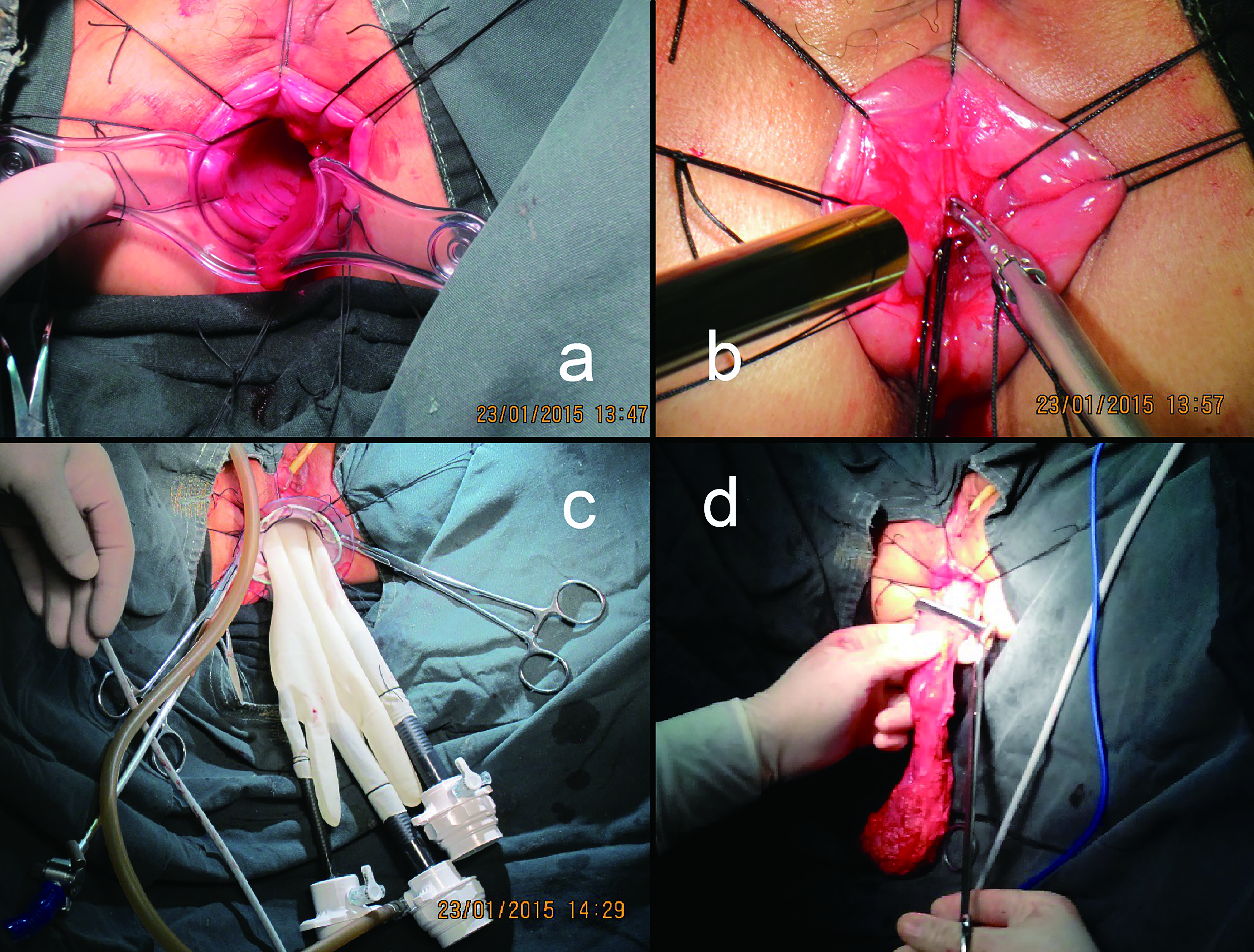|
Back to 2018 Posters
GLOVE SINGLE-PORT LAPAROSCOPY ASSISTED TRANSANAL TOTAL MESORECTAL EXCISION FOR LOW RECTAL CANCER: A PRELIMINARY REPORT
Wanglin Li*, Boye Dong, Qing Huang, Junbin Zhong, Jiabao Lu, Feng He, Jie Cao
Department of Colorectal Surgery, Guangzhou First People's Hospital, Guangzhou Medical University, Guangzhou, China
Background: Transanal total mesorectal excision (TaTME) is an emerging technique recently. Glove single-port laparoscopy assisted TaTME for low rectal cancer has been performed successfully in our department. And in our country, the cost of glove single-port is about 2000 dollars cheaper than the single item GelPoint platform. This study aimed to assess the technical feasibility of this innovative and low cost technique.
Methods: TaTME was completed under using glove single-port laparoscopic platform, and was performed combinedly through abdominal and transanal approaches. Outcomes including operative time, perioperative complications, quality of total mesorectal excision (TME), and follow-up results were evaluated.
Results: From January 2015 to June 2015, a total of 5 consecutive patients (three males and two females; with diagnosis of rectal cancer) were included. The mean distance from anal verge to tumor was 4.80±0.84 cm with a range of 4.0-6.0 cm. The mean age was 59.40±9.94 years and mean body mass index (BMI) was 23.20±2.22 kg/m2. All operations were performed successfully without conversions. The mean operative time was 338.00±46.04 min and mean estimated blood loss was 76.00±43.46 ml with a range of 50-150 ml. TME was complete in all cases and all circumferential margins were negative. The mean number of lymph nodes harvested was 12.20±0.84. There were no intraoperative and postoperative complications except one patient that developed a prolapsed ileostomy. The mean length of hospital stay was 8.60±1.14 days. During follow-up (14.80±1.92 months), all ileostomies were closed successfully, all patients were free of recurrence and had fully continent function.
Conclusion: Glove single-port laparoscopy assisted TaTME is safe and feasible for low rectal cancer in selected patients. Prospective randomized studies including larger sample size and long-term results are needed to validate this technique.
| | Patient#1 | Patient#2 | Patient#3 | Patient#4 | Patient#5 | Mean±SD | | Age(years) | 43 | 58 | 68 | 62 | 66 | 59.40±9.94 | | Gender | Female | Male | Male | Female | Male | - | | Body mass index(kg/m2) | 19.5 | 23.5 | 23.2 | 25.2 | 24.6 | 23.20±2.22 | | ASA score | 1 | 1 | 2 | 2 | 1 | - | | Underlying disease | No | No | HBP | No | No | - | | Previous abdominal operation | No | No | No | No | No | - | | Distance from AV(cm) | 5.0 | 6.0 | 4.0 | 5.0 | 4.0 | 4.80±0.84 | | Diameter of tumor(cm) | 1.5 | 3.0 | 2.0 | 2.5 | 2.0 | 2.20±0.57 | | Tumor position | Left lateral | Anterior | Posterior | Anterior | Anterior | - | | Operative time(min) | 280 | 360 | 400 | 310 | 340 | 338.00±46.04 | | Estimated blood loss(ml) | 50 | 150 | 50 | 80 | 50 | 76.00±43.46 | | Length of specimen(cm) | 9.0 | 10.0 | 8.0 | 9.0 | 10.0 | 9.20±0.84 | | Lymph nodes harvested | 12 | 13 | 11 | 12 | 13 | 12.20±0.84 | | (y)TNM stage | yT1N0M0 | T3N1M0 | T1N0M0 | T2N0M0 | T2N1M0 | - | | Circumferential margin | Negative | Negative | Negative | Negative | Negative | - | | Bowel movement(days) | 3 | 2 | 3 | 4 | 3 | 3.00±0.71 | | LOS(days) | 8 | 7 | 9 | 10 | 9 | 8.60±1.14 | | Conversion | No | No | No | No | No | - | | Reoperation | No | No | No | No | No | - | | Complications | No | Stoma prolapse | No | No | No | - | | 30-Days readmission | No | No | No | No | No | - | | Follow-up (months) | 17.0 | 16.0 | 14.0 | 15.0 | 12.0 | 14.80±1.92 |
ASA=American Society of Anesthesiologists. HBP=high blood pressure. (y): TNM stage for patients that received neoadjuvant chemoradiotherapy. LOS=length of hospital stay.  a: An anal retractor was applied to fully expose the rectum after washout with antiseptic solution, then make sure the position of the tumor and decide the exact incision in anal. b: Double purse strings were placed to tightly occlude the rectal lumen, then a full-thickness circumferential dissection was made in the proper perirectal plane. c: Single port was made by the glove and some trocars, then glove single port was inserted into the anal. d: The specimen was extracted through the anus.
Back to 2018 Posters
|

